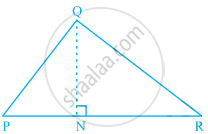Advertisements
Advertisements
Question
Find the area of ΔABC with vertices A(0, -1), B(2,1) and C(0, 3). Also, find the area of the triangle formed by joining the midpoints of its sides. Show that the ratio of the areas of two triangles is 4:1.
Solution
Let `A (x_1=0,y_1=-1), B (x_2 =2,y_2=1) and C (x_3 = 0, y_3=3) `be the given points. Then
`Area (Δ ABC)=1/2[x_1 (y_2-y_3)+ x_2(y_3-y_1) +x_3(y_1-y_3)]`
`=1/2 [0(1-3)+2(3+1)+0(-1-1)]`
`=1/2xx8=4` sq . units
So, the area of the triangle 4 ΔABC is sq units.
Let `D(a_1,b_1),E)a_2,b_2) and F (a_3,b_3)` be the midpoints of AB, BC and AC respectively
Then
`a_1 = (0+2)/2=1 b_2=(-1+1)/2=0`
`a_2=(2+0)/2=1 b_2=(1+3)/2=2`
`a_3=(0+0)/2=0 b_3 = (-1+3)/2=1`
Thus, the coordinates of D,E and F are D`(a_1=1,b_1=0),E(a_2=1,b_2=2) and F(a_3=0, b_3=1).` Now
`Area (ΔDEF)= 1/2 [a_1(b_2-b_2)+a_2(b_3-b_1)+a_3(b_1-b_2)]`
`=1/2 [1(2-1)+1(1-0)+0(0-2)]`
`=1/2[1+1+0]=1 `sq. units
So, the area of the triangle ΔDEF is 1 sq. unit.
Hence, ΔABC : ΔDEF = 4:1.
APPEARS IN
RELATED QUESTIONS
A(4, - 6), B(3,- 2) and C(5, 2) are the vertices of a 8 ABC and AD is its median. Prove that the median AD divides Δ ABC into two triangles of equal areas.
If the points A(−1, −4), B(b, c) and C(5, −1) are collinear and 2b + c = 4, find the values of b and c.
The two opposite vertices of a square are (− 1, 2) and (3, 2). Find the coordinates of the other two vertices.
If `a≠ b ≠ c`, prove that the points (a, a2), (b, b2), (c, c2) can never be collinear.
Find the area of a triangle whose sides are respectively 150 cm, 120 cm and 200 cm ?
Using determinants, find the values of k, if the area of triangle with vertices (–2, 0), (0, 4) and (0, k) is 4 square units.
The area of the triangle whose vertices are A(1, 2), B(-2, 3) and C(-3, -4) is ______.
Points A(–6, 10), B(–4, 6) and C(3, –8) are collinear such that AB = `2/9` AC.
Area of triangle PQR is 100 cm2 as shown in the below figure. If altitude QT is 10 cm, then its base PR is ______.

Area of a triangle = `1/2` base × ______.
